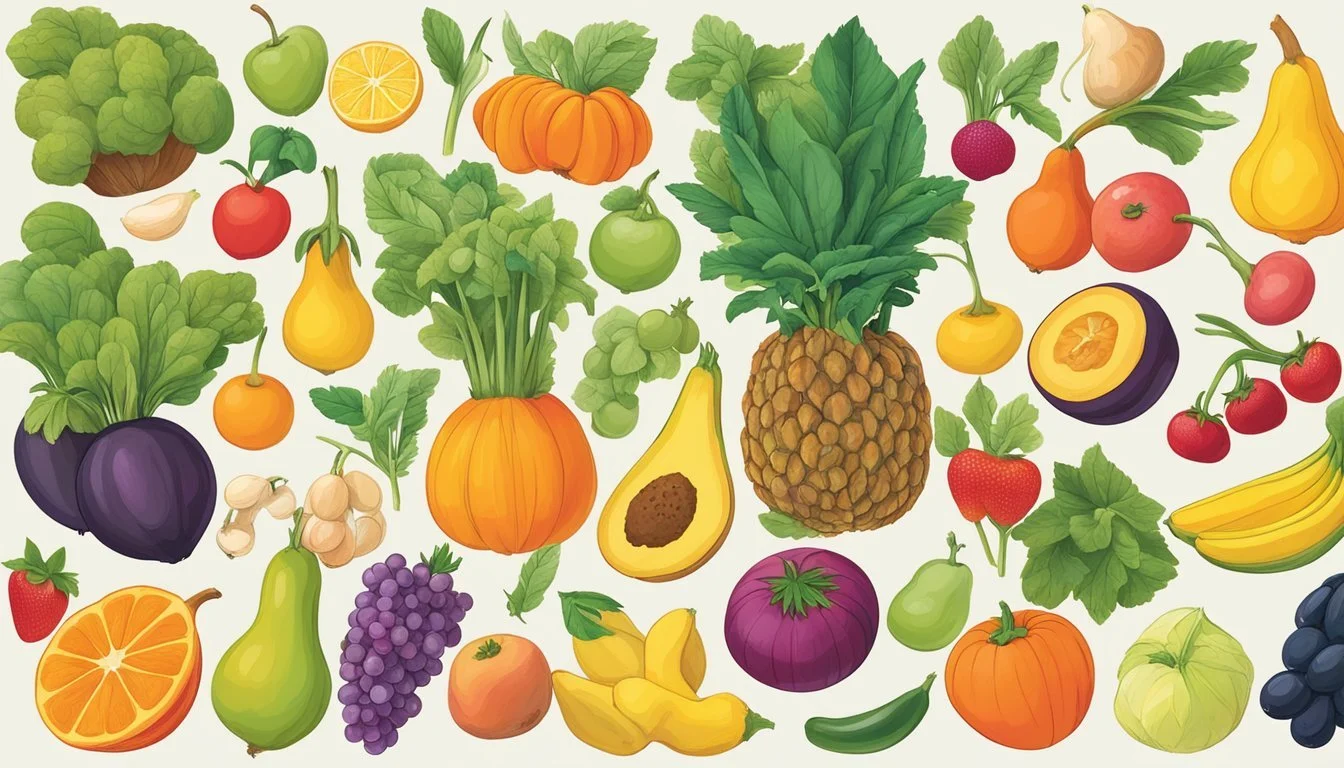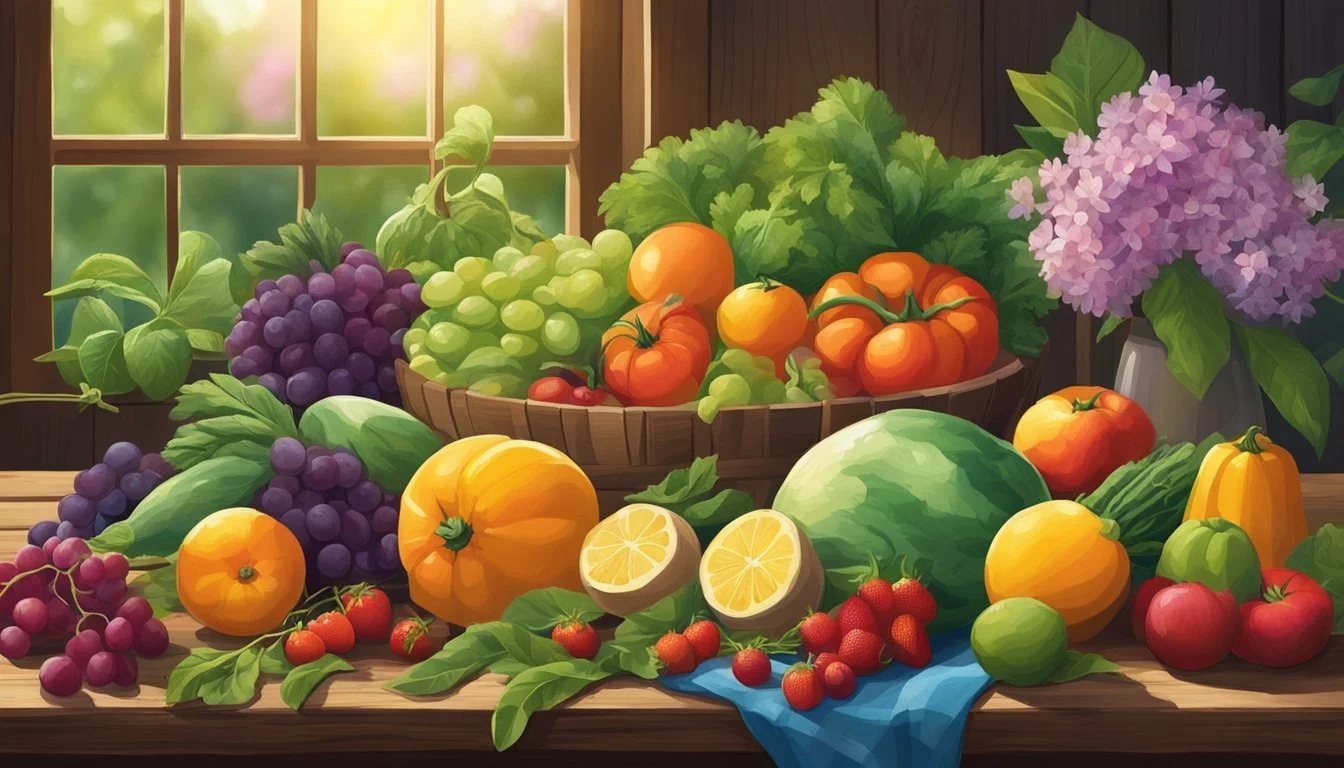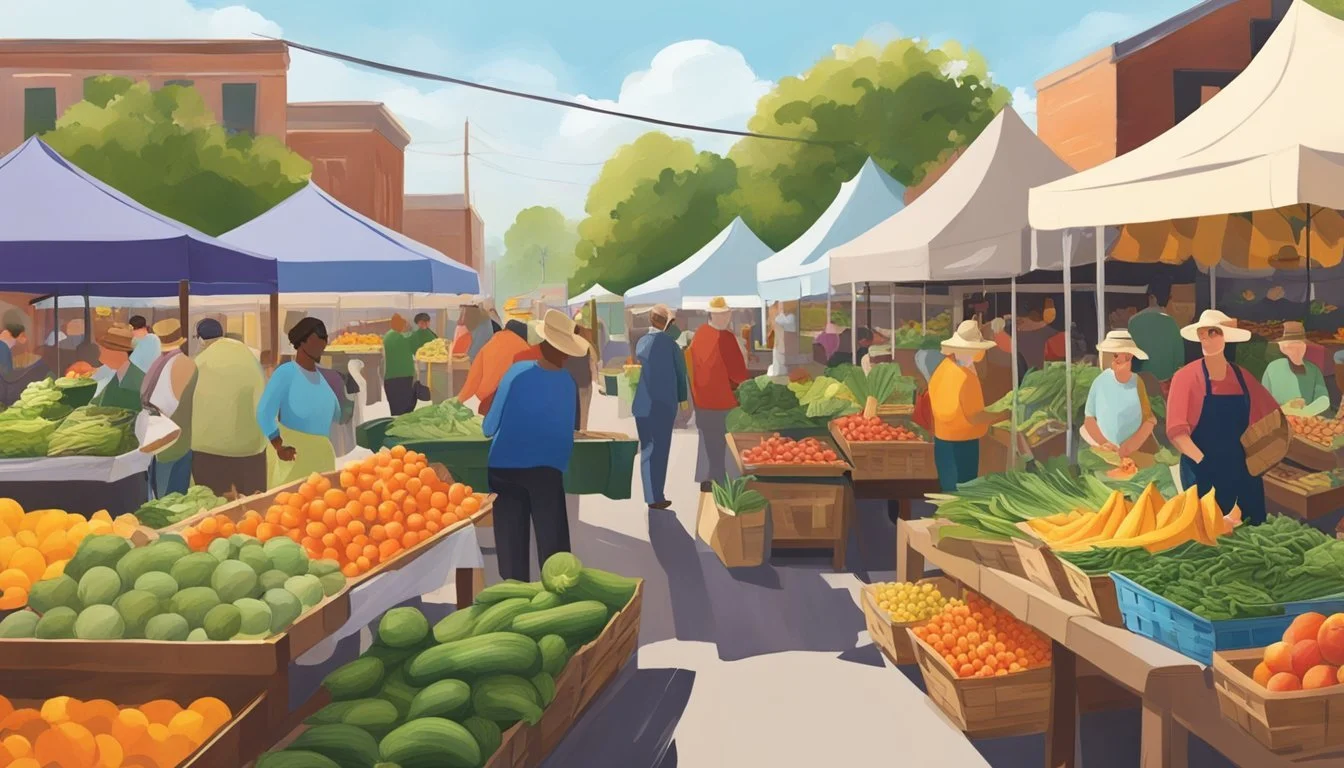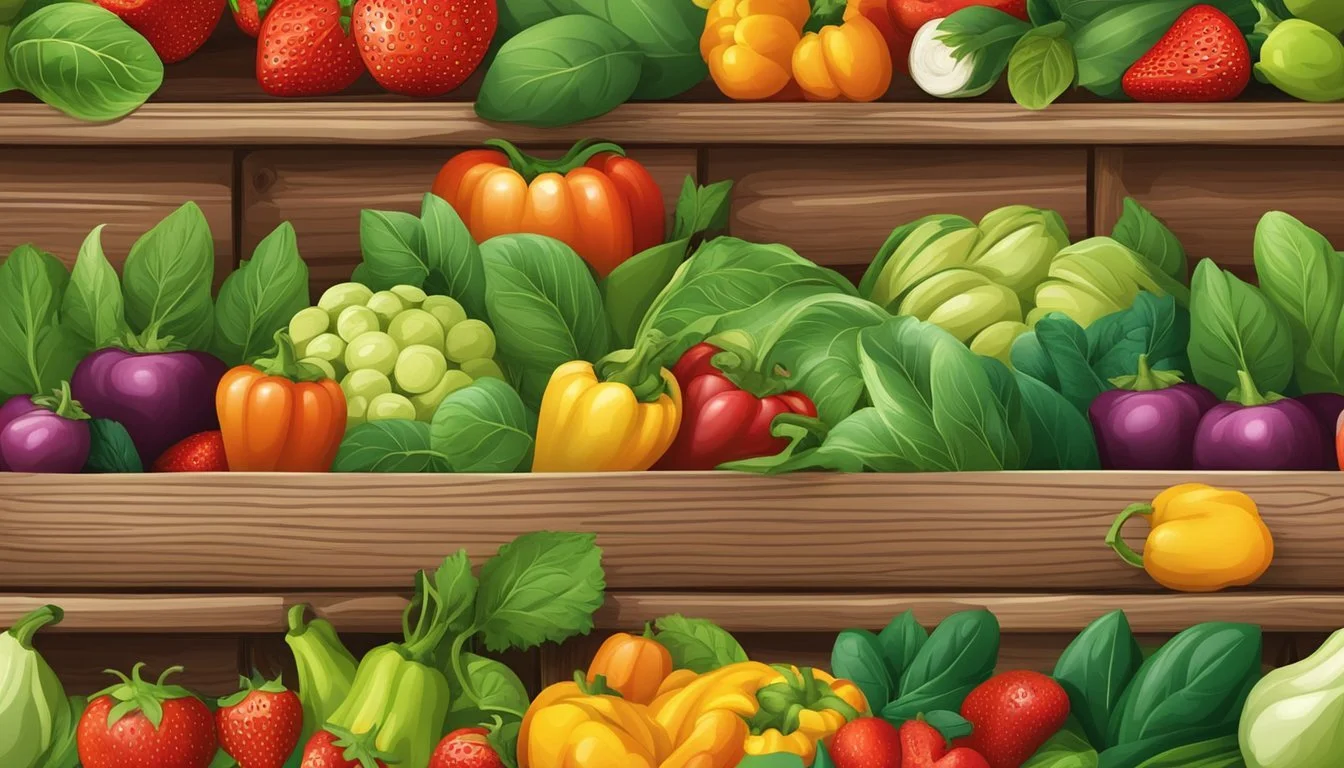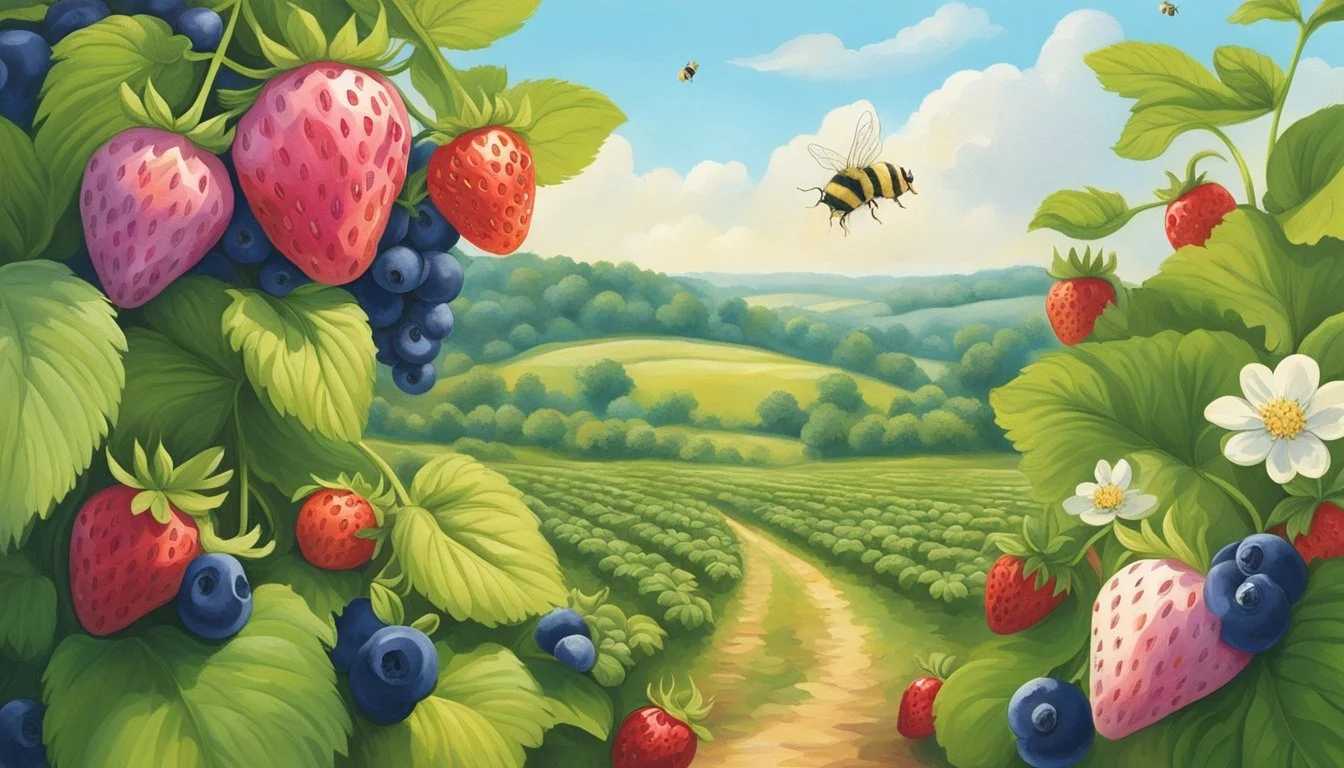Louisiana Seasonal Fruit & Vegetables in March
Your Fresh Picks Guide
This Article is Part of our Louisiana Seasonal Fruit & Veg Calendar
Louisiana's temperate climate and fertile soil lend themselves to a bountiful harvest, and during the month of March, a particular assortment of fruits (What wine goes well with fruit?) and vegetables begin to flourish. This time of year marks a seasonal transition, offering an array of produce at its peak freshness. Shoppers and culinary enthusiasts alike can expect to encounter a diverse spread from the state's farms and gardens.
Among the vibrant selection in March, cauliflower (how long does cauliflower last?) emerges as a versatile vegetable with its creamy white florets ready for a multitude of dishes. Collard greens (how long do collard greens last?) continue to thrive, providing a nutritious and flavorful leafy option that pairs well with both traditional and contemporary recipes. Meanwhile, the citrusy zest of clementines offers a sweet and tangy treat, signifying the tail-end of their season while being an excellent source of vitamin C.
While these products showcase the range of items available, it's important to note that Louisiana's warm climate allows for a longer growing period for many crops, extending their availability beyond the typical growing seasons found in cooler regions. This seasonal guide gives consumers insights into choosing local, ripe produce to enhance their cooking with the freshest flavors the region has to offer.
Key Produce of March in Louisiana
March in Louisiana heralds the arrival of several fresh fruits and vegetables at their peak. Shoppers can look forward to a variety of produce that is both vibrant in flavor and abundant.
Fruits Overview
Fruit Seasonality Strawberries Peak season Clementines Ending their season
Louisiana's mild winters allow for strawberries to flourish, and March sees these berries at their most succulent. Clementines, on the other hand, are winding down but can still be found fresh and sweet.
Vegetables Overview
Vegetable Seasonality Cauliflower Available Collard Greens Abundant throughout the month Broccoli (how long does broccoli last?) In season Cabbages Peak availability Carrots (how long do carrots last?) Crisp and sweet
Vegetables like cauliflower, collard greens, and broccoli are in abundance during March, offering a range of flavors and nutritional benefits. Cabbages and carrots are especially tender and flavorful this time of year, making them perfect for a variety of dishes.
Nutritional Benefits and Selection
When selecting fresh produce in Louisiana during March, one should focus on nutritional benefits and the peak of season freshness. Eating a variety of fruits and vegetables this month ensures a rich intake of vitamins, minerals, and antioxidants, which are crucial for maintaining good health.
Choosing Fresh Fruits
One should look for vibrant, unblemished fruit with a firm texture. For example, strawberries should be bright red with no soft spots or mold. The aroma of fruit can also indicate freshness—ripe strawberries often have a sweet, fragrant smell. March is an excellent month for citrus fruits such as oranges and tangerines which should feel heavy for their size, a sign they are juicy.
Strawberries: Choose bright red, firm, and fragrant.
Citrus Fruits: Select heavy, unblemished fruits; slight give when lightly squeezed.
Selecting Quality Vegetables
Vegetables harvested in March should appear vibrant and firm. Leaves of leafy greens like chard and collard greens should look crisp and dark green without yellowing edges. Root vegetables, like carrots, should be firm and smooth. If still attached, their greens can be an indicator of freshness—perky and vividly colored is ideal.
Leafy Greens: Look for dark green, crisp leaves.
Root Vegetables: Seek out firmness and smooth skin; greens should be perky if present.
Seasonal Recipes and Preparation
March in Louisiana brings a bounty of fruits and vegetables perfect for fresh, vibrant recipes. Utilizing these seasonal ingredients allows for optimal flavor and nutrition.
Fruit-Incorporated Dishes
Citrus: Clementines are sweet and juicy in March, excellent when added to salads or used for a citrus glaze on proteins.
Recipes:
Clementine and Beet Salad
Glazed Salmon with Clementine Salsa
Vegetable-Centric Cuisine
Greens: Collard greens are hearty and flavorful, suitable for slow-cooked dishes. Cruciferous Vegetables: Cauliflower and broccoli can be roasted or turned into warm salads. Root Vegetables: Carrots are sweet this time of year, ideal for roasting or in stews.
Recipes:
Garlic Roasted Cauliflower and Broccoli
Slow-Cooked Collard Greens with Ham Hocks
Honey-Glazed Roasted Carrots
Agricultural Practices in Louisiana
In Louisiana, agricultural practices are attuned to the state's unique climate and soil conditions, which allow for a variety of produce to thrive. These practices emphasize sustainability and direct market sales, contributing to the availability of fresh produce across the state.
Sustainable Farming
Louisiana’s farmers employ sustainable farming practices to ensure that they can continue to produce an ample variety of fruits and vegetables year after year. Crop rotation is common, helping to maintain soil health and prevent pest cycles. Cover cropping is another method used to enhance soil fertility and protect against erosion. Many farms also integrate pest management strategies that are organic and nature-friendly, minimizing the use of synthetic chemicals.
Local Farm Markets
Local farm markets are vital to Louisiana's fresh produce distribution, connecting consumers directly with the bounty of the state's harvest. These markets not only support the state's economy but also offer consumers access to fresh, locally-grown fruits and vegetables.
Baton Rouge: Red Stick Farmers Market
New Orleans: Crescent City Farmers Market
Shreveport: Shreveport Farmers' Market
These community hubs serve as a showcase for Louisiana's agricultural diversity, featuring seasonal specialties and fostering relationships between farmers and residents.
Month-by-Month Harvest Calendar
In March, Louisiana's rich soil and favorable climate bring a bounty of seasonal produce to the table. The harvest is diverse, ranging from crisp vegetables to juicy fruits. Here is a focused glimpse into what you can expect from local farms and gardens during this month.
Fruit Availability:
Grapefruit and oranges continue to be juicy picks, extending the citrus season's offerings.
Tangerines present a sweet and tangy option, perfect for snacking or salads.
Vegetable Harvest:
Leafy Greens: Kale, spinach, and various other greens are readily available, offering a versatile base for salads and side dishes.
Cruciferous Vegetables: Fresh broccoli and cauliflower make their way to the market, ideal for roasting or incorporating into warm dishes.
Root Vegetables: Carrots and sweet potatoes are in ample supply, lending their earthy flavors to a variety of culinary creations.
Legumes: Beans, depending on the specific variety, start to become available, adding a nutritious component to meals.
Alliums: Garlic, boasting its aromatic and flavor-enhancing qualities, is ready for harvest.
While not all included entities are in season, it’s prudent to note the focus on what is presently harvested to ensure freshness and support local agriculture. Herbs also widely available in March contribute further depth to the palate and allow for flavor experimentation and enrichment in dishes. Dark green, nutrient-packed vegetables are a highlight of the month, ushering in a celebration of healthful eating.
Food Preservation and Storage
Preserving the freshness of produce is paramount for enjoying Louisiana's seasonal fruits and vegetables at their peak. Proper techniques not only extend the shelf life but also lock in the nutrients and flavors.
Canning and Freezing
For fruits like strawberries and blueberries, which are abundant in March, canning and freezing are effective methods to preserve their freshness. Canning should be done using the hot water bath method to ensure the fruit maintains its taste and safety for consumption. Freezing these fruits can be as simple as laying them out on a baking sheet to freeze individually before transferring them to an airtight container.
When it comes to vegetables such as cucumbers and green beans, blanching before freezing can help preserve texture and color. Vegetables with a higher water content, like cucumbers, are better suited for pickling, a form of canning, which adds a flavorful brine and can extend the shelf life significantly.
Long-Term Storage Tips
For vegetables that are harvested during this month—such as cauliflower, collard greens, and potatoes—proper long-term storage is key for maintaining their quality. A cool, dark, and well-ventilated space is ideal. Here are specific tips for these vegetables:
Cauliflower: Best kept in a refrigerator in a perforated plastic bag to allow airflow and reduce moisture accumulation.
Collard Greens: Store in the refrigerator wrapped in a damp paper towel and placed in a plastic bag to maintain humidity.
Potatoes: Should be stored in a cool, dark place with good ventilation to prevent spoilage and retain texture.
These methods maximize the use of Louisiana's seasonal produce while maintaining food safety and reducing waste.
Community and Cultural Events
March in Louisiana is not only a time for observing the emergence of spring but also a period when the state's focus on fresh produce is celebrated through various community events and cultural festivals.
Food Festivals
Louisiana is renowned for its vibrant food scene, and March brings several food festivals spotlighting local fruits and vegetables. For example, the Louisiana Strawberry Festival in Ponchatoula celebrates the peak strawberry harvest with parades, live music, and plenty of strawberry-themed dishes. Visitors can relish fresh, locally-grown strawberries in various forms — from jams to pies.
Farmers Markets Announcements
Farmers markets throughout the state announce their seasonal openings in March, inviting residents and visitors to enjoy fresh, local produce. Markets such as the Red Stick Farmers Market in Baton Rouge make public their schedules for the upcoming season, providing details on vendor lists and new produce entries. These markets often highlight seasonal crops like fava beans (how long do fava beans last?) and kale, ensuring that attendees have access to the finest selections of the month.
Healthy Eating and Seasonal Diets
Emphasizing fresh and seasonal produce is a cornerstone of maintaining a healthy diet. In Louisiana, March marks the availability of an array of nutrient-rich fruits and vegetables that can be incorporated into daily meals.
Dietary Plans
To maximize health benefits, individuals often integrate seasonal fruits and vegetables into their dietary plans. For Louisiana residents, March presents options such as asparagus and beets, which are excellent for supporting a heart-healthy diet. Fruits like strawberries begin to appear and can be a sweet, fiber-rich addition to any meal. Planning a diet around the season ensures the freshest produce, thus providing a higher content of vitamins and antioxidants due to reduced time from farm to table.
Seasonal vegetables in March also provide an opportunity for those following low-carb or ketogenic diets. Greens such as spinach and kale are low in carbohydrates while being high in fiber and essential minerals. They are versatile for salads, smoothies, or as a cooked side dish.
Nutrient-Rich Food Combinations
Intentional pairing of foods can elevate the nutritional value of a meal. For example, combining vitamin C-rich strawberries with iron-packed spinach in a salad can enhance iron absorption from the greens.
Seasonal Combination Benefits Strawberry Spinach Salad Vitamin C enhancing iron absorption Roasted Beets and Asparagus Fiber for digestion, folate for cell repair
Louisiana's March produce also offers an array of options for creating colorful, vitamin-enriched salads that are both visually appealing and health-supporting. Including a variety of fruits and vegetables in these salads ensures a spectrum of nutrients that work synergistically for optimal health.
Environmental Impact of Seasonal Eating
Eating seasonally, especially in regions like Louisiana, has a tangible effect on the environment. This practice primarily contributes to reducing the carbon footprint associated with food transport and supports the local economy through the agriculture sector.
Reducing Carbon Footprint
Seasonal eating in Louisiana often means that the fresh produce does not travel vast distances to reach the consumer. When fruits and vegetables are obtained locally, they bypass the extensive supply chains that are necessary for out-of-season or non-local produce. For most fresh commodities, a shorter travel distance equates to lower carbon emissions. This not only lessens the burden on the environment significantly but also ensures that the fresh produce retains more nutrients, as the time between harvest and consumption is minimized.
Supporting Local Economy
Choosing to eat seasonally also directly helps boost the local market and agriculture. By purchasing seasonal fruits and vegetables from local farms and markets, consumers can ensure that their money is invested back into the state's economy. These transactions fortify the agricultural sector, create jobs, and can lead to reinvestment in more sustainable farming practices. As farmers see steady demand for their seasonal crops, they are incentivized to maintain or even expand their environmentally friendly practices, which in turn can lead to a more sustainable food system within the state.
Growing Your Own
March in Louisiana offers the perfect opportunity to start a fruitful season of backyard bounty, with favorable temperatures and conditions aligning for an array of produce. Gardeners can embrace the start of the warm season by planting a mix of vegetables, fruits, and herbs.
Home Gardening Tips
Gardeners should take advantage of Louisiana’s mild spring temperatures to establish their gardens. Soil preparation is key; one should ensure the soil is well-aerated and rich in organic matter. Mulching can help retain moisture and keep weeds at bay. It’s also the opportune time to set up rain barrels or an irrigation system to manage water throughout the growing season.
When it comes to spacing, plants should have enough room to grow without competing for nutrients—follow spacing directions specific to each plant species. Companion planting can be beneficial; for example, planting basil near tomatoes can help repel pests.
Selecting Seeds and Seedlings
Choosing the right seeds and seedlings is crucial for a successful harvest:
Vegetables: Gardeners should look for early season varieties of vegetables like snap beans, radishes, and corn. It's also time to plant leafy greens such as collards.
Vegetables Plant Type Planting Method Snap beans Seed Direct sow in well-drained soil Radishes Seed Direct sow or use seed tapes Corn Seed Direct sow in blocks for pollination Collards Seed/Seedling Can start indoors or direct sow
Fruits: While March may still be early for some fruits, gardeners can plant certain fruit-bearing plants like strawberries.
Fruits Plant Type Planting Method Strawberries Seedling Plant in well-draining soil, spaced adequately
Herbs: This is a good time to start herbs, which can be grown from seeds or seedlings. Herbs like parsley and cilantro can be planted now.
Herbs Plant Type Planting Method Parsley Seed/Seedling Plant in pots or in-ground with spaced out rows Cilantro Seed/Seedling Sow in well-drained soil, partial shade to full sun
For the best results, gardeners should select high-quality, disease-resistant seeds and seedlings from reputable sources. They should read labels for planting instructions and provide appropriate care as per each plant’s needs from germination to harvest.
Louisiana's Seasonal Food Guide
In Louisiana, March marks a vibrant transition in local produce offerings. This month, the state is abundant with a wide variety of fresh fruits and vegetables. Buyers can anticipate spring greens which are at their peak, bringing a bounty of dark green vegetables to markets and stores.
Fruits:
Strawberries begin to sweeten the scene, often hitting their stride toward the end of the month.
Citrus fruits, particularly oranges and grapefruits, still make a juicy appearance, continuing their season from the colder months.
Vegetables: Louisiana’s fertile land yields an assortment of vegetables, with different subgroups becoming readily available:
Dark Green Vegetables: Look for spring greens such as spinach and collards, which not only offer bold flavors but also an array of nutritional benefits.
Red/Orange Vegetables: Carrots and sweet potatoes maintain their presence, carrying over their vibrant hues from the winter.
A highlight in the cities and the rural areas alike is the presence of farmers' markets that bring the farm to the urban table. The Louisiana Department of Health promotes the consumption of in-season, local produce. Their advocacy benefits both the local economy and consumer health, ensuring that the freshest, most nutrient-rich produce is accessible.
Here is the produce to look for in Louisiana during March, formatted for clarity:
Fruits
Strawberries: Late March
Citrus fruits: Ongoing season
Vegetables
Dark Green Vegetables:
Spinach
Collard Greens
Red/Orange Vegetables:
Carrots
Sweet Potatoes
These selections make it an ideal time for incorporating a cornucopia of colors and nutrients into one's diet. Fresh produce from Louisiana in March is a testament to the state’s agricultural richness and signals the beginning of a fruitful season ahead.



